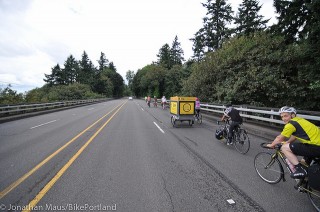A few times each day on the wooded four-lane stretch of inner SW Barbur Boulevard, state data released last week suggest, someone decides to hit the gas and zoom through at an average 55 mph or more.
And about a dozen times each year, Barbur’s crash history suggests, someone on this part of Barbur loses control of their vehicle and hits something. Once or twice a year, someone dies.
Since narrowing the road in this stretch to one lane in each direction appears to make many fewer people choose to hit the gas, a redesign that would replace one of the northbound lanes with a bike lane and walking path in each direction could be seen as a perfect test case for Vision Zero. That’s the principle, endorsed by Portland’s transportation director, that safety is always a higher priority than convenience when it comes to road design.
But even if you don’t subscribe to that philosophy, a local traffic engineering analyst has sent us an interesting email making the case that redesigning Barbur would also pay off using the current U.S. system that estimates the economic cost of injuries and deaths.
Here’s the unabashedly back-of-the-envelope calculation from the analyst, Brian Davis of Lancaster Engineering (disclaimer: this the same firm that has sponsored BikePortland in the past and who we share our office with). He’s drawing on two figures:
- 68 seconds of additional average travel time on Tuesday, Wednesday and Thursday during the period when northbound Barbur is congested (7 a.m. to 9 p.m.)
- A 37 percent drop in collision rates observed on other Portland streets that were narrowed from four lanes to two plus a turn lane.
Advertisement
Here’s a lightly edited version of Davis’s email, explaining his calculations:
The 68-second figure is probably an overstatement (even given that, as you discussed, delays the other two weekdays will be much lower). The travel time between April (2 NB lanes) and June/July (1 lane steadily closed for construction) is only 12 seconds. It increases another 56 seconds during the October period, when you have “intermittent lane closures.” As ODOT states, “This is likely attributable to the combination of seasonal variation (school being in session) and a more intense construction period in which the lane closure configuration varied from day to day.”
Well, that’s a factual statement, but I’d bet it’s far more heavily the latter than the former. In Portland proper, we simply don’t see all that much seasonal variation. The decrease in traffic from school being out is more-or-less cancelled out by an increase in tourist and recreational activity. The construction there is mattering greatly.
Still, even using the 68 second figure, we get an annual loss to the regional economy of only $442,000 due to the increased congestion.
Assuming the system is below capacity the rest of the day and there’s no significant delay from the lane reduction as a consequence (I think that’s what the report implies), then the 3,000 vehicles travelling in the morning will each experience that but few other cars will be affected.
If I then assume an occupancy of 1.5 people/vehicle, the daily added delay from the lane reduction is 85 people-hours. So let’s assume a cost of the delay to be something like $20/person-hour. With 260 work days per year (and don’t forget, the delays will be lower by ODOTs estimation on Monday & Friday, so now we’re overstating things), that means the lane reduction (if the observed effects were permanent) would result in a loss of about $442,000 in productivity.
Davis is only counting the productivity costs in the northbound direction. If we assume that narrowing Barbur in both directions would create a similar delay for southbound traffic, we’d be up to $884,000 in lost productivity. But even that, Davis said, would be dwarfed by the economic advantages of a safer street.
I pulled the last five years of crash data for the affected segment of Barbur between Hamilton and Bertha. The data show that the road is every bit as deadly as we suspected, with 6 fatal crashes, another 62 injury crashes, and 53 non-injury crashes from 1/1/2009 to 12/31/2013. Using the 2009 Highway Safety Manual’s crash costs, I can calculate the annual cost of crashes along the segment to be $5,596,000.
The PBOT study that you wrote about a few weeks ago found a 37% reduction in crashes along road dieted segments. While I think this road diet would be pretty different in character, it certainly seems reasonable that we might see similar reductions in crash numbers and severity given that we saw speeds pretty significantly reduced. That would save a little over $2,000,000 each year in crash costs.
I asked Davis if it was really fair to assume a 37 percent reduction in crashes, since that figure was based on more urban streets in east-central Portland that have lots of intersections.
It’s a good question. Without considering the PBOT study findings, if we can say that if the road diet reduced crash frequencies and severity by at least 8%, then we’ve outweighed the cost of the additional delay. Certainly, we would exceed that.
So even from a cold actuarial perspective where time is money, lives have prices, and money talks, the road diet would represent an overall benefit to the region’s economy.
I’m sure this is only one of many ways to look at this problem, and it’s admittedly a pretty rough estimate. Even so, let’s put it on a chart:
For a redesigned Barbur to not have economic benefits, these rough estimates would have to be pretty far off.




